1967年,文[1]发现第1颗脉冲星后,脉冲星被认证是快速旋转的中子星[2]。脉冲星提供了远远超出地球实验室所能达到的极端物理条件[3-5],为现代物理学包括广义相对论、核物理和粒子物理等学科开拓了新的视野,也对现有理论形成了巨大的推动。因此脉冲星一直是天文学和物理学的研究重点和热点[6-9]。近年来,随着观测技术的进步,发现了大量脉冲星。到目前为止,观测到的脉冲星总数已超过2500颗,其中射电脉冲星的周期分布范围从1.39ms到8.5s[10]。
脉冲星性质参数的统计研究是中子星研究中重要的基础性工作,已经有一些这方面的研究工作[11-15]。文[15]对脉冲星的自转周期和表面磁场进行了统计,并利用这些结果分析了脉冲星相关理论。然而脉冲星还有其它重要性质,比如脉冲星的空间位置、特征年龄、射电光度和自转能损失率等。关于这些参数的统计分布研究较少,需要进一步仔细探索。
本文利用ATNF Pulsar Catalogue (http://www.atnf.csiro.au/research/pulsar/psrcat/)中最近的数据,对脉冲星空间位置参数进行统计分析,并研究常规脉冲星射电光度和自转能损失率随着特征年龄的变化,为脉冲星的演化机制研究提供基础[16-18]。
1 脉冲星的空间分布统计截止2016年7月,ATNF Pulsar Catalogue列出了观测到的2536颗脉冲星(到2017年3月已有2573颗)的各种参数。这些参数包括自转周期P和自转周期变化率
图 1给出了截止2016年7月,ATNF Pulsar Catalogue列出的脉冲星的自转周期和周期变化率的分布。图中左下部为毫秒脉冲星,右上中部为常规脉冲星。在图中还给出了高能脉冲星,包括X射线脉冲星、伽马射线脉冲星和光学脉冲星。根据特征年龄可以看到,毫秒脉冲星是较老的脉冲星[16-17],这些脉冲星的表面磁场相对较弱。
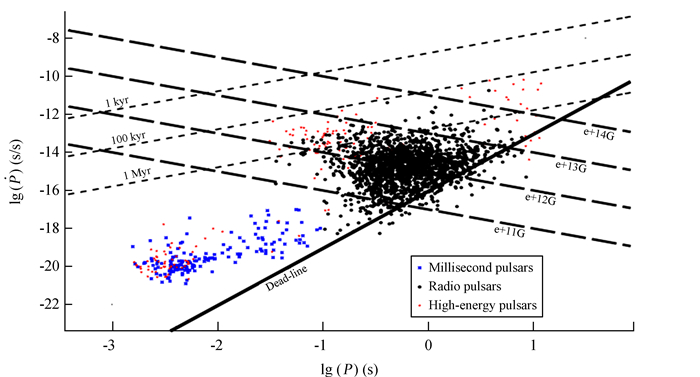
|
|
图 1 观测到的脉冲星周期P和周期变化率 |
ATNF Pulsar Catalogue还列出了脉冲星的空间位置信息,根据这些信息可以对脉冲星的空间位置分布进行统计研究。
首先给出脉冲星在银道坐标系中的分布,如图 2。与普通恒星一样,脉冲星主要集中分布在银道面上,同时还有一部分脉冲星分布在高银纬的区域,这可能是由于脉冲星在诞生时有很高的自行速度,使其现在的位置已经偏离了诞生的位置。毫秒脉冲星通过吸积产生,存在时间较长[21-22],在银河系中运行的时间较长,因此它的分布比较弥散。
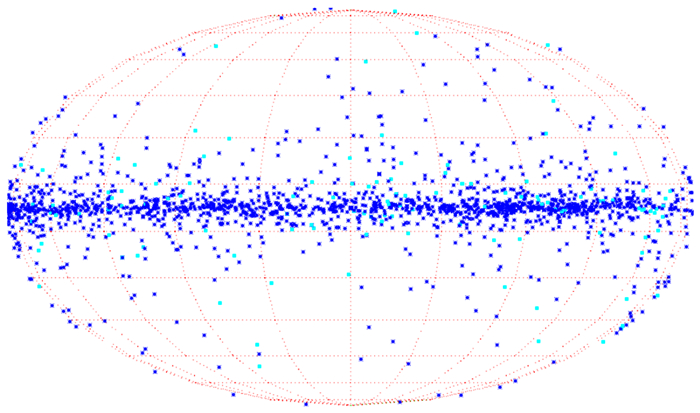
|
| 图 2 脉冲星在银道坐标系中的空间分布。蓝色点代表常规脉冲星,绿色点代表毫秒脉冲星 Figure 2 Spatial distribution of pulsars in Galactic Coordinate System. Blue refers to normal pulsar, Green refers to millisecond pulsar |
图 3给出了脉冲星投影到银道面上的分布。图中两条直线的交点是太阳系。
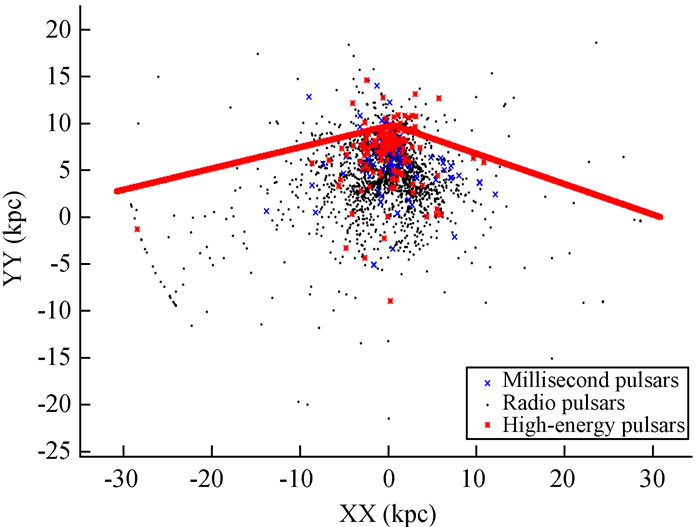
|
| 图 3 脉冲星投影在银道面上的分布图 Figure 3 Distribution of pulsar projections on the Galactic Plane |
从图 3可以看出,脉冲星倾向于分布在太阳系的一边,毫秒脉冲星这种倾向更明显。这可能是观测的选择效应(包括星际色散和散射)引起的[23-25]。
将脉冲星投影到银道面后,统计这些脉冲星在银道面内离银心和太阳距离的分布,结果如图 4。从图 4 (a)看到,在距离银心约7.27kpc处,脉冲星分布数目有一个最大值,而银心处的脉冲星数目较少,这可能是因为银心附近物质密度很高,对辐射的散射效应很强造成的。统计脉冲星离太阳的距离分布,如图 4 (b),可以看到这种观测效应明显减弱。
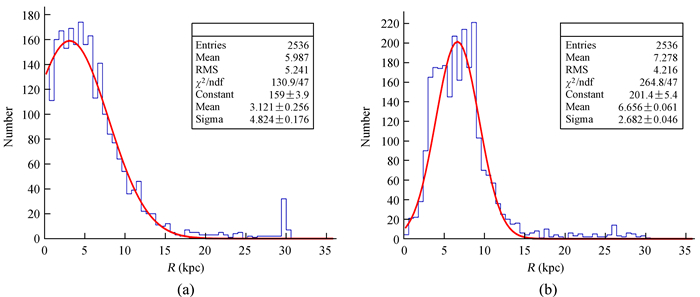
|
| 图 4 脉冲星与太阳和银心距离的分布。(a)离太阳的距离;(b)离银心的距离 Figure 4 The distribution of the distance from pulsar to the sun or the galactic center. Rbscissa represents the distance from pulsar to the sun or the galactic center respectively |
为了研究脉冲星的主要参数自转周期、表面磁场和特征年龄的空间分布,统计计算了常规脉冲星离银道面不同距离处的3个参量的平均值,结果如图 5。
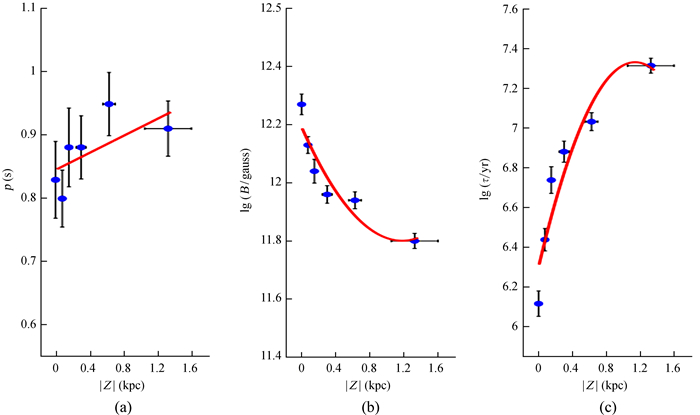
|
| 图 5 常规脉冲星的自转周期(a)、表面磁场(b)和特征年龄(c)随银道面距离的变化 Figure 5 Period (a), surface magnetic field (b) and characteristic age (c) of normal pulsar as a function of the distance from pulsar to the galactic plane |
从图 5可以看出,随着离银道面的距离|Z|增大,自转周期逐渐增大,表面磁场减少,特征年龄增大。
脉冲星通过自转减慢将自转能的损失转化为辐射。同样统计计算了自转能损失率随银道面距离的变化,结果如图 6。从图 6可以得到,自转能损失率随着远离银道面(|Z|增大)而不断下降。

|
| 图 6 自转能损失率随银道面距离的变化 Figure 6 The relationship between loss rate of rotational kinetic energy and the distance from pulsar to the galactic plane |
对图 5和图 6自转周期、表面磁场、特征年龄和自转能损失率随银道面距离的变化规律进行了拟合计算,结果如下:
自转周期的线性拟合P=(0.4203±0.01451) |Z|+(0.0704±0.04207),拟合的结果很可靠。而表面磁场、特征年龄和自转能损失率采用二次线性拟合,拟合函数的形式为
| $ y = {p_0} + {p_1}\left| Z \right| + {p_2}{\left| Z \right|^2}, $ | (1) |
其中,|Z|为离银道面的距离(kpc);y为表面磁场(gauss)、特征年龄(year)或者自转能损失率(erg/s), p0, p1, p2为拟合系数。拟合系数结果列在表 1中。
| y | p0 | p1 | p2 | χ2/ndf |
| lg(B) | 6.096 ± 0.01173 | -0.6631 ± 0.1085 | 0.2811 ± 0.07622 | 14.21/3 |
| lg(τ) | 3.151 ± 0.02133 | 1.812 ± 0.1815 | -0.7958 ± 0.1242 | 23.87/3 |
| lg( |
16.51 ± 0.02927 | -2.32 ± 0.2429 | 1.051 ± 0.1658 | 17.46/3 |
从表 1可以看出,脉冲星表面磁场B、特征年龄τ和自转能损失率
射电光度、自转能损失率是衡量脉冲星演化的重要参数,由它们可以进一步描述脉冲星的演化状态。利用常规脉冲星的射电光度和自转能损失率随着年龄的变化讨论研究脉冲星的演化。
利用已有脉冲星的观测结果,统计计算了射电光度和自转能损失率平均值随特征年龄的变化,结果如图 7、图 8。

|
| 图 7 常规脉冲星射电光度RLum随特征年龄τ的变化 Figure 7 The radio luminosity of normal pulsar RLum as a function of characteristic age τ |

|
|
图 8 常规脉冲星自转能损失率 |
从图 7可以看出,随着特征年龄的增大,射电光度先增大后减小。也就是说,年轻脉冲星的射电光度随特征年龄(τ<106.5year)增大,特征年龄达到106.5年后开始随年龄下降。射电光度随年龄变化的规律为
| $ {\rm{lg}}{R_{{\rm{Lum}}}} = \left( { - 1.996 \pm 0.6044} \right){({\rm{lg}}\tau )^2} + \left( {2.024 \pm 0.3600} \right){\rm{lg}}\tau \\ + \left( { - 0.1634 \pm 0.0258} \right), $ | (2) |
拟合结果可靠。
而之前认为射电光度随年龄的增大而下降[26],这与现有的观测统计结果不完全符合,意味着年轻脉冲星辐射机制需要进行深入的理论研究。
图 8为常规脉冲星自转能损失率随特征年龄的变化,随着特征年龄的增大,自转能损失率快速对数下降。变化规律为
| $ {\rm{lg}}\dot E = \left( {0.1096 \pm 0.0028} \right){\left( {{\rm{lg}}\tau } \right)^2} + \left( { - 2.522 \pm 0.0476} \right){\rm{lg}}\tau + \left( {22.18 \pm 0.1001} \right), $ | (3) |
拟合结果可靠。
3 总结利用最新的脉冲星观测数据,对2500多颗脉冲星的参数空间分布和演化进行了统计计算分析。脉冲星主要分布在银道面附近,统计脉冲星在银道面内离银心和太阳的距离分布,发现脉冲星数目分布的极大值位于距离银心约7.27kpc处,这可能是星际色散和散射造成的观测选择效应。
统计计算了常规脉冲星的自转周期、表面磁场和特征年龄等参量随着远离银道面的变化,并拟合给出了它们的变化规律。结果显示,随着远离银道面,常规脉冲星的自转周期和特征年龄不断增大,表面磁场和自转能损失率不断减小。
统计计算分析了常规脉冲星射电光度和自转能损失率随特征年龄的变化,结果发现,常规脉冲星自转能损失率随特征年龄增大呈对数快速下降,而射电光度随特征年龄的增大先增大后减小。也就是说,射电辐射机制在不同特征年龄段有所不同。这些结果是脉冲星分布演化理论研究的重要基础。
| [1] | Hewish A, Bell S J, Pilkington J D H, et al. Observation of a rapidly pulsating radio source[J]. Nature, 1968, 217(5130): 709–713. DOI: 10.1038/217709a0 |
| [2] | Gold T. Rotating neutron stars as the origin of the pulsating radio sources[J]. Nature, 1968, 218(5143): 731–732. DOI: 10.1038/218731a0 |
| [3] | Burderi L, King A R. A firm upper limit to the radius of the neutron star in SAX J1808.4-3658[J]. The Astrophysical Journal, 1998, 505(2): L135–L137. DOI: 10.1086/311611 |
| [4] | Miller C. Astronomy:twinkle, twinkle, neutron star[J]. Nature, 2002, 420(6911): 31–33. DOI: 10.1038/420031a |
| [5] | Özel F. Soft equations of state for neutron-star matter ruled out by EXO 0748-676[J]. Nature, 2006, 441(7097): 1115–1117. DOI: 10.1038/nature04858 |
| [6] | Li J, Torres D F, Zhang S, et al. Unveiling the super-orbital modulation of LS I+61° 303 in X-Rays[J]. The Astrophysical Journal Letters, 2011, 744(1): L13–L14. |
| [7] | Li J, Torres D F, Zhang S, et al. INTEGRAL and swift observations of the be X-ray binary 4U 1036-56(RX J1037.5-5647) and its possible relation with γ-ray transients[J]. The Astrophysical Journal, 2012, 761(1): 1702–1711. |
| [8] | Tang Y, Yang C Y, Zhang L, et al. A self-consistent explanation of TeV emissions from HESS J1640-465 and HESS J1641-463[J]. The Astrophysical Journal, 2015, 812(1): 32–37. DOI: 10.1088/0004-637X/812/1/32 |
| [9] | Tang Y Y, Dai Z C, Zhang L. Modeling multiband emissions from two young SNRs with a time-dependent magnetic field[J]. Research in Astronomy and Astrophysics, 2013, 13(5): 537–546. DOI: 10.1088/1674-4527/13/5/005 |
| [10] | Manchester R N, Hobbs G B, Teoh A, et al. The Australia telescope national facility pulsar catalogue[J]. The Astronomical Journal, 2005, 129(4): 1993–2006. DOI: 10.1086/428488 |
| [11] |
程争, 张承民, 赵永恒, 等. 中子星质量分布的统计研究[J]. 天文学报, 2013, 54(6): 514–526 Cheng Zheng, Zhang Chengmin, Zhao Yongheng, et al. A statistical study on neutron star masses[J]. Acta Astronomica Sinica, 2013, 54(6): 514–526. |
| [12] |
杨佚沿, 张承民, 王德华, 等. 双中子星质量分布的统计研究[J]. 天文学报, 2016, 57(6): 647–656 Yang Yiyan, Zhang Chengmin, Wang Dehua, et al. A statistical study on double neutron star masses[J]. Acta Astronomica Sinica, 2016, 57(6): 647–656. |
| [13] | Kontorovich V M. The magnetic fields of radio pulsars[J]. Astronomy Reports, 2015, 59(4): 277–287. DOI: 10.1134/S1063772915040046 |
| [14] | Loginov A A, Nikitina E B, Malov I F. The space velocities of radio pulsars[J]. Astronomy Reports, 2016, 60(2): 193–203. DOI: 10.1134/S1063772916020062 |
| [15] | Cai Y, Ali T, Zhao Y H, et al. Statistics and evolution of pulsars' parameters[J]. Chinese Astronomy and Astrophysics, 2012, 36(2): 137–147. DOI: 10.1016/j.chinastron.2012.04.003 |
| [16] |
张月竹, 付妍妍, 魏益焕, 等. 脉冲星减速研究与电磁和引力波辐射[J]. 天文学报, 2015, 56(3): 235–242 Zhang Yuezhu, Fu Yanyan, Wei Yihuan, et al. Spin-down of pulsars, and their electromagnetic and gravitational wave radiation[J]. Acta Astronomica Sinica, 2015, 56(3): 235–242. |
| [17] |
张承民, 杨国琛, 刘明成. 中子星的磁场演化[J]. 天文学进展, 1994, 12(2): 91–99 Zhang Chengmin, Yang Guochen, Liu Mingcheng. Evolution of the magnetic field of neutron star[J]. Acta Astronomica Sinica, 1994, 12(2): 91–99. |
| [18] |
李林森. 脉冲星磁辐射制动力矩对具有磁辐射的两成分模型自旋的长期减速[J]. 天文研究与技术, 2016, 13(3): 277–283 Li Linsen. The impact of magnetic radiation braking torque on the secular retardation of spin of two-components of pulsar[J]. Astronomical Research & Technology, 2016, 13(3): 277–283. |
| [19] | Lyne A G, Graham-Smith F. Pulsar astronomy[M]. Cambridge: Cambridge University Press, 2012. |
| [20] | Shapiro S L, Teukolsky S A, Lightman A P. Black holes, white dwarfs, and neutron stars:the physics of compact objects[M]. New York: Wiley-Interscience, 1983. |
| [21] | Wang J, Zhang C M, Chang H K. Testing the accretion-induced field-decay and spin-up model for recycled pulsars[J]. Astronomy & Astrophysics, 2012, 540(4): 753–791. |
| [22] | Zhang C M, Kojima Y. The bottom magnetic field and magnetosphere evolution of neutron star in low-mass X-ray binary[J]. Monthly Notices of the Royal Astronomical Society, 2006, 366(1): 137–143. DOI: 10.1111/j.1365-2966.2005.09802.x |
| [23] | Rickett B J. Interstellar scintillation and pulsar intensity variations[J]. Monthly Notices of the Royal Astronomical Society, 1970, 150(1): 67–91. DOI: 10.1093/mnras/150.1.67 |
| [24] | Xu X Y, Wang C, Han J L, et al. The best detection conditions for pulsars in the Galactic disk[J]. Science China Physics, Mechanics and Astronomy, 2011, 54(3): 552–557. DOI: 10.1007/s11433-011-4260-x |
| [25] | Lorimer D R. Radio pulsar populations[C]//High-Energy Emission from Pulsars and their Systems. Berlin:Springer Berlin Heidelberg, 2011:21-36. |
| [26] | Szary A, Zhang B, Melikidze G I, et al. Radio efficiency of pulsars[J]. The Astrophysical Journal, 2014, 784(1): 59–67. DOI: 10.1088/0004-637X/784/1/59 |



